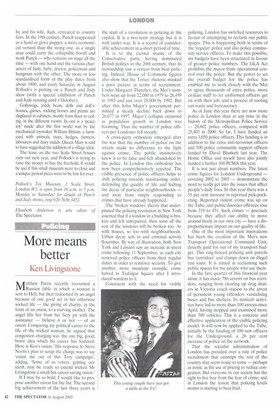Mr Punch revisited
Elisabeth Anderson
Afew hundred yards from the computer and high-tech shops of Tottenham Court Road sit two smallish houses. one 18th-century, the other 19th. Step inside and you appear to have left the 21st century behind. Pollock's Toy Museum is the fulfilment of an adult's childhood dreams: a treasure house of old-fashioned toys.
Some 50 years ago, Marguerite Fawdry bought the entire stock of one of London's last toy-theatre-makers, Benjamin Pollock Ltd, which had gone bankrupt. And it was because of her passion for traditional toys and the theatre that the museum and its shop survive today.
Fawdry, born in 1912, was the daughter of an English mother and French father; she was educated at the Lye& in South Kensington and after university in Lille joined the London Theatre Studio, where her fellow students included Peter Ustinov and Alec Guinness. Instead of becoming an actress, however, she decided on a career in journalism, working for the BBC's French section and in the press office of General de Gaulle's Free French headquarters at the start of the second world war.
Marguerite married during the war and had a son. And it was because of the family's enthusiasm for miniature theatre that she took over the bankrupt Benjamin Pollock, later renting a room in Covent Garden from where she began selling toy theatres and accessories.
Toy theatre — or juvenile drama — began in Regency times, when adult theatre was gaining in popularity. A set consisted of drawings of actors, scenery and props in a successful contemporary play, suitable for cutting out and mounting on cardboard for a performance. The cardboard figures and props were moved on metal long-handled slides across a small model stage; at the same time an assistant would recite a condensed version of the text. There were usually eight to 12 sheets in a complete set, which could be bought for a 'penny plain, twopence coloured'. Great care was taken to reproduce faithfully the costumes and features of the actors, as well as the details of wings, backdrop, scenery and props. In the early 19th century, there were about 300 plays in the toy-theatre repertory, including works by Shakespeare, Pocock and Boucicault. And in the museum there is a collection of toy theatres, the oldest on display being one by William West dated 1820, with characters and scenes from The Maid and the Magpie, a folk tale along the lines of Rossini's La gazza ladra. Cut-out toy theatres based on 19thcentury models can be bought in the shop.
The museum is a higgledy-piggledy set of six small connecting rooms on three floors. In the first room there are a number of 19th-century optical toys, including a pair of stereoscopic viewers, invented by Sir Charles Wheatstone in 1832 to demonstrate how we are able to see depth — three-dimensional vision. In another room there is a large collection of puppets. including Javanese shadow puppets. These have a repertoire of plays originating in the Hindu epics. the Mahabharata and Ramayana. Performances take place in front of a screen to an audience of men, while the women sit behind and watch the shadow side.
But perhaps the best-known puppet show is Punch and Judy. It used to be a familiar sight on the streets of large cities, presented on the miniature stage of a tall, collapsible booth covered with striped canvas. Nowadays, Punch and Judy shows can only occasionally be found at the seaside. Punch evolved from the Pulcinella of the commedia dell'ade and first appeared in London as part of the Italian marionette shows popular after the Restoration. In the early years of the 18th century, however, Londoners grew tired of the antics of this rogue, and so
he and his wife, Judy, retreated to country fairs. In the 19th century, Punch reappeared as a hand or glove puppet, a more economical version than the string one, as a single man could carry the collapsible booth and work Punch — who remains on stage all the time — with one hand and the various characters of Judy, baby, doctor, policeman and hangman with the other. The more or less standardised form of the play dates from about 1800, and every Saturday in August Pollock's is putting on a Punch and Judy show (with a special exhibition of Punch and Judy running until 4 October).
Gollywogs, teddy bears, dolls and doll'shouses, games, rocking horses and prams are displayed in cabinets, mostly from floor to ceiling, in the different rooms. In one is a 'peace toy' made after the first world war by the mechanical to maker William Britain: a farmyard with animals, trees, hedges, farmers, labourers and dairy maids. Queen Mary is said to have suggested the addition of a village idiot.
The lease on the two Scala Street houses runs out next year, and Pollock's is trying to raise the money to buy the freehold. It would be sad if this small museum were to close and a unique period piece were to be lost for ever.
Pollock's Toy Museum, 1 Scala Street, London Wl, is open from 10 a.m. to 5 p.m. Monday to Saturday; for details of Punch and Judy shows, ring 020 7636 3452.
Elisabeth Anderson is arts editor of The Spectator.











































































 Previous page
Previous page